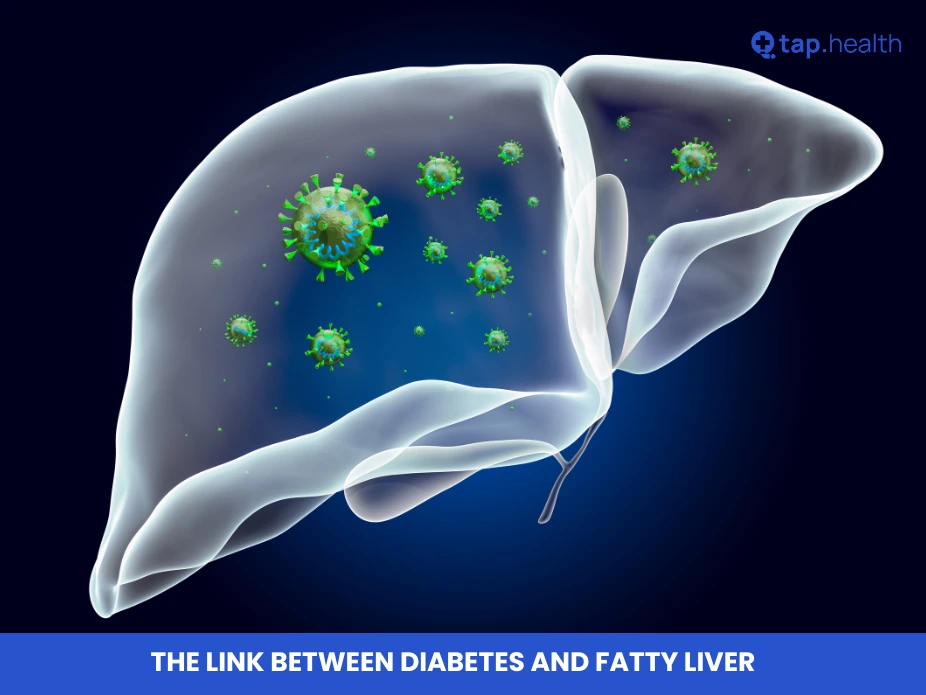Diabetes and fatty liver disease, particularly non-alcoholic fatty liver disease (NAFLD), share a strong interconnection driven by metabolic factors. Type 2 diabetes heightens the risk of NAFLD due to insulin resistance and obesity. This blog delves into causes, risks, and effective management strategies for both conditions.
What Causes Fatty Liver in Diabetes Patients?
Fatty liver develops when fat exceeds 5% of liver weight. NAFLD, unrelated to alcohol, links directly to Type 2 diabetes via insulin resistance. High insulin levels promote liver fat storage, inhibiting fat breakdown and leading to inflammation.
How Does Insulin Resistance Link Diabetes to NAFLD?
Insulin resistance, core to Type 2 diabetes, forces excess insulin production. This overloads liver cells with fat, progressing to non-alcoholic steatohepatitis (NASH). Elevated insulin boosts fat synthesis while blocking its removal, creating a cycle of liver damage.
Why Is Obesity a Key Factor in Diabetes and Liver Fat Buildup?
Obesity, especially visceral fat, floods the bloodstream with free fatty acids that deposit in the liver. This worsens insulin resistance, accelerating NAFLD. Excess weight ties both conditions, increasing risks of fibrosis and liver failure.
What Role Do High Blood Sugar Levels Play in Fatty Liver Progression?
Chronic hyperglycemia in diabetes stimulates liver glucose production, converting it to stored fat. This reinforces insulin resistance, forming a vicious cycle that exacerbates NAFLD and metabolic disturbances.
How Do Inflammation and Oxidative Stress Connect Diabetes and Fatty Liver?
Both conditions involve systemic inflammation and oxidative stress. Insulin resistance triggers liver cell damage, while free radical imbalance causes injury and scarring, advancing NAFLD to severe stages like cirrhosis.
Major Risks When Diabetes Coexists with Fatty Liver Disease
Co-occurrence amplifies complications. Key risks include:
- Cirrhosis Progression: NAFLD to NASH to cirrhosis rises with diabetes due to combined fat accumulation and inflammation.
- Cardiovascular Threats: Heightened heart disease and stroke risk from shared insulin resistance and inflammation.
- Liver Cancer Development: NASH with cirrhosis elevates hepatocellular carcinoma odds.
- Kidney Complications: Diabetic nephropathy worsens with NAFLD via underlying metabolic issues.
Effective Management Strategies for Diabetes and NAFLD
Comprehensive approaches target lifestyle, medication, and monitoring to reverse fatty liver and control diabetes.
What Dietary Changes Help Manage Diabetes and Reduce Liver Fat?
Adopt low glycemic index foods like whole grains, vegetables, and legumes to stabilize blood sugar. Include healthy fats from avocados, nuts, and fatty fish for better insulin sensitivity. Prioritize lean proteins; avoid sugars and refined carbs to curb liver fat storage.
How Does Exercise Improve Insulin Sensitivity and Liver Health?
Aerobic activities like walking and resistance training reduce visceral fat, enhancing insulin response. Regular movement decreases liver fat, breaks the diabetes-NAFLD cycle, and supports weight loss.
Which Medications Aid Both Type 2 Diabetes and Fatty Liver?
Metformin improves insulin sensitivity and blood sugar. GLP-1 agonists promote weight loss and liver benefits. SGLT2 inhibitors lower glucose with potential NAFLD advantages. Supplements like vitamin E may reduce inflammation under medical supervision.
Why Is Weight Loss Crucial for Reversing NAFLD in Diabetics?
Losing 5-10% body weight significantly cuts liver fat and boosts insulin sensitivity, preventing progression to NASH or cirrhosis.
How Important Is Regular Monitoring for Early Detection?
Blood tests, liver function panels, and imaging like ultrasound detect NAFLD early in diabetes patients, enabling timely interventions to avoid complications.
Real-Life Examples of Managing Diabetes and Fatty Liver
Emily, 42, with Type 2 diabetes and NAFLD, lost 12 pounds via low-carb diet and daily walks. Her blood sugar stabilized, and liver fat decreased in six months.
Mike, 50, battling obesity, diabetes, and NASH, followed medication, strict diet, and mixed exercise. After a year, liver tests improved, reducing his diabetes meds.
Expert Insights on Diabetes and NAFLD Connection
Dr. Linda Williams, Endocrinologist: “Insulin resistance bridges diabetes and fatty liver. Lifestyle integration with weight management and monitoring optimizes outcomes.”
Dr. John Davis, Hepatologist: “NAFLD surges in Type 2 diabetes. Early diagnosis via diet, exercise, and meds halts severe damage.”
Evidence-Based Recommendations for Diabetes and Liver Health
Studies in The Lancet Diabetes & Endocrinology confirm weight loss via lifestyle reduces liver fat and insulin resistance, lowering complication risks. Focus on proven interventions for sustainable results.
Can Fatty Liver Be Reversed with Diabetes Management?
Yes, through weight loss, healthy diet, and exercise.
How to Prevent NAFLD if You Have Type 2 Diabetes?
Control blood sugar, maintain healthy weight, follow low-glycemic eating.
Is NAFLD Common in Diabetes Patients?
Yes, due to insulin resistance and obesity prevalence.
Do Medications Help Both Conditions?
Metformin, GLP-1 agonists manage blood sugar and support liver health.
How Can TapHealth Help Manage Diabetes and Fatty Liver?
TapHealth offers personalized tools for tracking blood sugar, diet, and exercise to combat diabetes and NAFLD effectively.
- Fatty Liver Disease and Diabetes: A Global Challenge
- NAFLD and Its Connection with Insulin Resistance
FAQs on The Link Between Diabetes and Fatty Liver
Q1: Can fatty liver disease be reversed?
Yes, fatty liver disease can often be reversed with lifestyle changes such as weight loss, a healthy diet, and regular exercise.
Q2: How can I prevent fatty liver disease if I have diabetes?
Managing blood sugar levels, maintaining a healthy weight, and adopting a balanced, low-glycemic diet are key to preventing fatty liver disease.
Q3: Is fatty liver disease common in people with Type 2 diabetes?
Yes, individuals with Type 2 diabetes are at a higher risk of developing fatty liver disease due to insulin resistance and obesity.
Q4: Can medications help manage both diabetes and fatty liver disease?
Yes, certain medications, such as metformin and GLP-1 agonists, can help manage both blood sugar levels and liver health.



